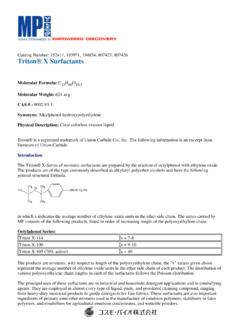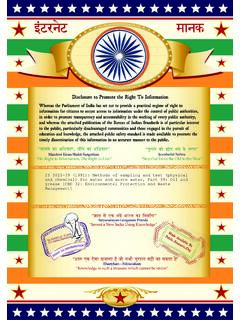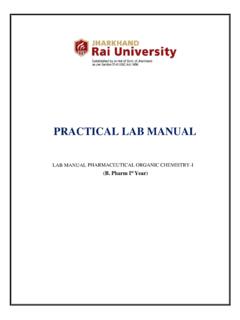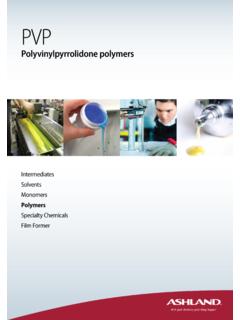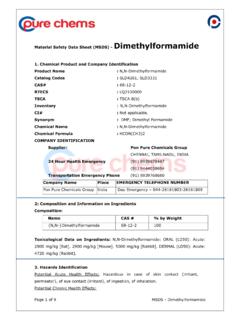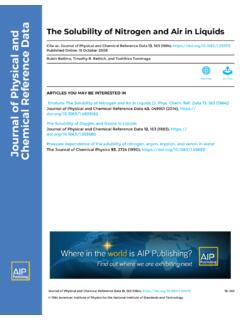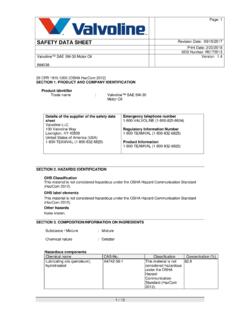Transcription of SAFETY DATA SHEET TOLUENE - FIS Chem
1 Revision date: 25/08/2017 Revision: 3 Supersedes date: 29/12/2016 SAFETY data SHEETTOLUENESECTION 1: Identification of the substance/mixture and of the Product identifierProduct nameTOLUENEP roduct numberTOENREACH registration number01-2119471310-51-XXXXCAS number108-88-3EU index number601-021-00-3EC Relevant identified uses of the substance or mixture and uses advised againstIdentified usesIndustrial SolventUses advised againstThe substance is not recommended for professional or consumer use other than the identifiedapplication Details of the supplier of the SAFETY data sheetSupplierFIS Chemicals CroftBucksburnAberdeen AB21 9 TNTel: 01224 723796 Fax: 01224 Emergency telephone numberEmergency telephone01224 723796 (Office hours only)SECTION 2: Hazards Classification of the substance or mixtureClassification (EC 1272/2008)Physical hazardsFlam. Liq. 2 - H225 Health hazardsSkin Irrit. 2 - H315 Repr. 2 - H361d STOT SE 3 - H336 STOT RE 2 - H373 Asp.
2 Tox. 1 - H304 Environmental hazardsNot ClassifiedClassification (67/548/EEC or1999/45/EC)F;R11 Repr. Cat. 3;R63 Xn;R48/20,R65 Xi;R38 Label elementsEC number203-625-91/9 Revision date: 25/08/2017 Revision: 3 Supersedes date: 29/12/2016 TOLUENEP ictogram Signal wordDangerHazard statementsH225 Highly flammable liquid and May be fatal if swallowed and enters Causes skin May cause drowsiness or Suspected of damaging the unborn May cause damage to organs through prolonged or repeated statementsP201 Obtain special instructions before Do not handle until all SAFETY precautions have been read and Keep away from heat, hot surfaces, sparks, open flames and other ignition sources. Ground/ bond container and receiving Use explosion-proof electrical Use only non-sparking Take precautionary measures against static Do not breathe vapour/ Avoid breathing vapour/ Wash contaminated skin thoroughly after Use only outdoors or in a well-ventilated Wear protective gloves/ protective clothing/ eye protection/ face +P310 IF SWALLOWED: Immediately call a POISON CENTER/ +P352 IF ON SKIN: Wash with plenty of +P361+P353 IF ON SKIN (or hair): Take off immediately all contaminated skin with water/ +P340 IF INHALED: Remove person to fresh air and keep comfortable for +P313 IF exposed or concerned: Get medical advice/ Call a POISON CENTER/ doctor if you feel Get medical advice/ attention if you feel Specific treatment (see medical advice on this label).
3 P331 Do NOT induce +P313 If skin irritation occurs: Get medical advice/ +P364 Take off contaminated clothing and wash it before +P378 In case of fire: Use foam, carbon dioxide, dry powder or water fog to +P233 Store in a well-ventilated place. Keep container tightly +P235 Store in a well-ventilated place. Keep Store locked Dispose of contents/ container in accordance with national date: 25/08/2017 Revision: 3 Supersedes date: 29/12/2016 TOLUENES upplementary precautionarystatementsP201 Obtain special instructions before Do not handle until all SAFETY precautions have been read and Keep away from heat, hot surfaces, sparks, open flames and other ignition sources. Ground/ bond container and receiving Use explosion-proof electrical Use only non-sparking Do not breathe vapour/ Wash contaminated skin thoroughly after +P352 IF ON SKIN: Wash with plenty of +P313 IF exposed or concerned: Get medical advice/ Get medical advice/ attention if you feel Specific treatment (see medical advice on this label).
4 P332+P313 If skin irritation occurs: Get medical advice/ +P364 Take off contaminated clothing and wash it before +P235 Store in a well-ventilated place. Keep Other hazardsThis substance is not classified as PBT or vPvB according to current EU criteria. Not availableSECTION 3: Composition/information on SubstancesProduct nameTOLUENEREACH registration number01-2119471310-51-XXXXEU index number601-021-00-3 CAS number108-88-3EC number203-625-9 SECTION 4: First aid Description of first aid measuresInhalationRemove affected person from source of contamination. Keep affected person warm and atrest. Get medical attention not induce vomiting. Rinse mouth thoroughly with water. Give plenty of water to affected person to fresh air and keep warm and at rest in a position comfortable forbreathing. Get medical contactRemove contaminated clothing immediately and wash skin with soap and water. Get contactRemove any contact lenses and open eyelids wide apart.
5 Continue to rinse for at least 15minutes and get medical Most important symptoms and effects, both acute and delayedInhalationMay cause drowsiness or dizziness. Symptoms following overexposure may include thefollowing: Headache. Fatigue. Dizziness. Central nervous system depression. May causeunconsciousness, blindness and possibly be fatal if swallowed and enters contactCauses skin contactMay cause temporary eye date: 25/08/2017 Revision: 3 Supersedes date: 29/12 Indication of any immediate medical attention and special treatment neededNotes for the doctorNo specific recommendations. If in doubt, get medical attention 5: Firefighting Extinguishing mediaSuitable extinguishing mediaExtinguish with alcohol-resistant foam, carbon dioxide, dry powder or water Special hazards arising from the substance or mixtureSpecific hazardsOxides of the following substances: Carbon. Highly flammable liquid and vapour.
6 Vapours areheavier than air and may spread near ground and travel a considerable distance to a sourceof ignition and flash Advice for firefightersProtective actions duringfirefightingContainers close to fire should be removed or cooled with protective equipmentfor firefightersWear positive-pressure self-contained breathing apparatus (SCBA) and appropriate 6: Accidental release Personal precautions, protective equipment and emergency proceduresPersonal precautionsNo smoking, sparks, flames or other sources of ignition near spillage. Take precautionarymeasures against static discharges. Provide adequate Environmental precautionsEnvironmental precautionsSpillages or uncontrolled discharges into watercourses must be reported immediately to theEnvironmental Agency or other appropriate regulatory Methods and material for containment and cleaning upMethods for cleaning upEliminate all sources of ignition. No smoking, sparks, flames or other sources of ignition nearspillage.
7 Provide adequate ventilation. Wear suitable protective equipment, including gloves,goggles/face shield, respirator, boots, clothing or apron, as appropriate. Absorb spillage withinert, damp, non-combustible material. Flush contaminated area with plenty of water. Collectand place in suitable waste disposal containers and seal securely. For waste disposal, seeSection Reference to other sectionsReference to other sectionsWear protective clothing as described in Section 8 of this SAFETY data 7: Handling and Precautions for safe handlingUsage precautionsPregnant or breastfeeding women should not work with this product if there is any risk ofexposure. Avoid spilling. Avoid contact with skin and eyes. Keep away from heat, sparks andopen flame. Eliminate all sources of ignition. Provide adequate ventilation. Static electricityand formation of sparks must be Conditions for safe storage, including any incompatibilitiesStorage precautionsHighly flammable liquid and vapour.
8 Keep away from heat, sparks and open flame. Store intightly-closed, original container in a dry, cool and well-ventilated place. Take precautionarymeasures against static classFlammable liquid Specific end use(s)4/9 Revision date: 25/08/2017 Revision: 3 Supersedes date: 29/12/2016 TOLUENES pecific end use(s)The identified uses for this product are detailed in Section 8: Exposure Controls/personal Control parametersOccupational exposure limitsLong-term exposure limit (8-hour TWA): WEL 50 ppm 191 mg/m Short-term exposure limit (15-minute): WEL 100 ppm 384 mg/m SkWEL = Workplace Exposure LimitSk = Can be absorbed through - Inhalation; Long term systemic effects: 192 mg/m Industry - Inhalation; Short term systemic effects: 384 mg/m Industry - Inhalation; Long term local effects: 192 mg/m Industry - Inhalation; Short term systemic effects: 384 mg/m Industry - Dermal; Long term systemic effects: 384 mg/kg/dayPNECI ndustry - Fresh water; mg/lIndustry - Marine water; mg/lIndustry - Intermittent release; mg/lIndustry - STP.
9 Mg/lIndustry - Sediment (Freshwater); mg/kgIndustry - Sediment (Marinewater); Exposure controlsProtective equipment Appropriate engineeringcontrolsProvide adequate general and local exhaust protectionThe following protection should be worn: Chemical splash goggles. Personal protectiveequipment for eye and face protection should comply with European Standard protectionChemical-resistant, impervious gloves complying with an approved standard should be worn ifa risk assessment indicates skin contact is possible. The most suitable glove should bechosen in consultation with the glove supplier/manufacturer, who can provide informationabout the breakthrough time of the glove material. The selected gloves should have abreakthrough time of at least 8 hours. Polyvinyl alcohol (PVA). Viton rubber (fluoro rubber).EN 374 Other skin and bodyprotectionWear appropriate clothing to prevent repeated or prolonged skin contact.
10 Provide eyewashstation and SAFETY measuresGood personal hygiene procedures should be implemented. When using do not eat, drink orsmoke. Wash at the end of each work shift and before eating, smoking and using the protectionIf ventilation is inadequate, suitable respiratory protection must be worn. Combination filter,type A2 9: Physical and Chemical Information on basic physical and chemical propertiesAppearanceClear date: 25/08/2017 Revision: 3 Supersedes date: 29/12/2016 TOLUENEO douraromatic hydrocarbonsMelting point~ -95 CInitial boiling point and range~ 110 C @ 760 mm HgFlash point4 C CC (Closed cup).Upper/lower flammability orexplosive limitsLower flammable/explosive limit: % Upper flammable/explosive limit: 8 %Vapour pressure3 - kPa @ CVapour @ 20 CSolubility(ies)Insoluble in temperature480 m /s @ 35 Other informationOther informationNo information 10: Stability and ReactivityReactivityThere are no known reactivity hazards associated with this Chemical stabilityStabilityStable at normal ambient Possibility of hazardous reactionsPossibility of hazardousreactionsWill not Conditions to avoidConditions to avoidAvoid heat, flames and other sources of ignition.
